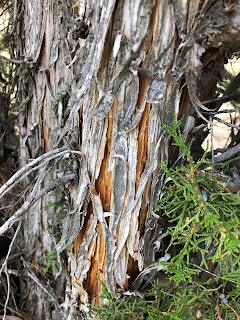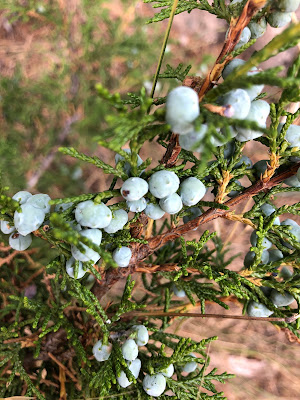Rocky Mountain Juniper is a slow growing, tough, drought resistant plant that can live for centuries. The average height of an 8 year old tree is only 1 foot tall. Junipers grow in some of the harshest sites in the Northern Hemisphere and can survive on as little as 10 inches of water a year; they're also able to withstand the extreme temperatures of the high desert. As junipers mature they become very intolerant of shade, which means larger, faster growing trees outcompete them on less harsh sites. They are also more commonly killed by surface fires that larger Ponderosa Pine and Douglas-Fir can withstand. Grazing has expanded Juniper habitat since it reduces competition from native grasses. Once established, junipers' root system emits a chemical compound that inhibits the growth of nearby vegetation. This competitive edge is termed allelopathy (a fancy word for plant bullying).
You can recognize these bushy little trees by their irregular canopies, divided trunks, and fibrous shaggy bark that hangs in strips. The foliage is a little tricky because the juvenile shoots have different leaves from the mature trees. On young trees you'll find prickly 1/2 inch leaves, but older plants have tiny scalelike leaves radiating on the branches from all sides. The most recognizable parts of the plant are the cones, which are commonly referred to as juniper berries. Only the female trees have berries, and these berries take 2 years to mature, beginning as a greenish ball with a white waxy bloom and turning to a silvery blue. Junipers begin bearing seeds at 10-20 years old and reach their peak production at 50-200 years. By the time us women are hitting menopause, lady junipers are just starting to hit their stride of peak fertility.
 |
| Mature Leaves |
Birds are the primary disseminators of the seeds. Juniper berries pass through the birds' digestive tract unharmed, and the scarification of the outer coating encourages germination. You can spot where birds have enjoyed sitting and pooping by the presence of Juniper - along fence lines seems to be a favorite. According to the author of Northwest Trees, "one scientists found that 900 rocky mountain juniper berries passed through a single bohemian waxwing in one hour." I'm curious about his methods of counting berries in bird poop. What a job. Robins, turkeys, and jays also eat the berries. Bighorn sheep and deer tend to browse juniper only as a last resort, preferring other vegetation for forage.
Rocky Mountain Juniper was used medicinally by indigenous people throughout the West. The Blackfoot made an infusion of the berries to treat vomiting and used a decoction of the leaves mixed with turpentine to rub on arthritic joints. The Cheyenne used a steambath of the berries for treating colds and fevers, and they burned incense for protection from thunder and lightning. If you've ever been in a thunderstorm in the mountains or high desert, you'll probably understand why this was a thing. The fibrous bark was used as kindling, and it could be woven into a rope that would smolder and could be used to carry fire from place to place. Starting a fire with a bow drill is hard work - much better to be able to transport some embers and not have to sweat so much. Juniper was also valued as firewood and was used for making bows. Settlers made use of the rot resistant wood for fence posts and planted Junipers as wind breaks. And last but definitely not least, Juniper berries are the botanical that is used in gin. You are legally not allowed to call your beverage gin if it doesn't contain Juniper berries.
 |
| Juvenile Leaves |




